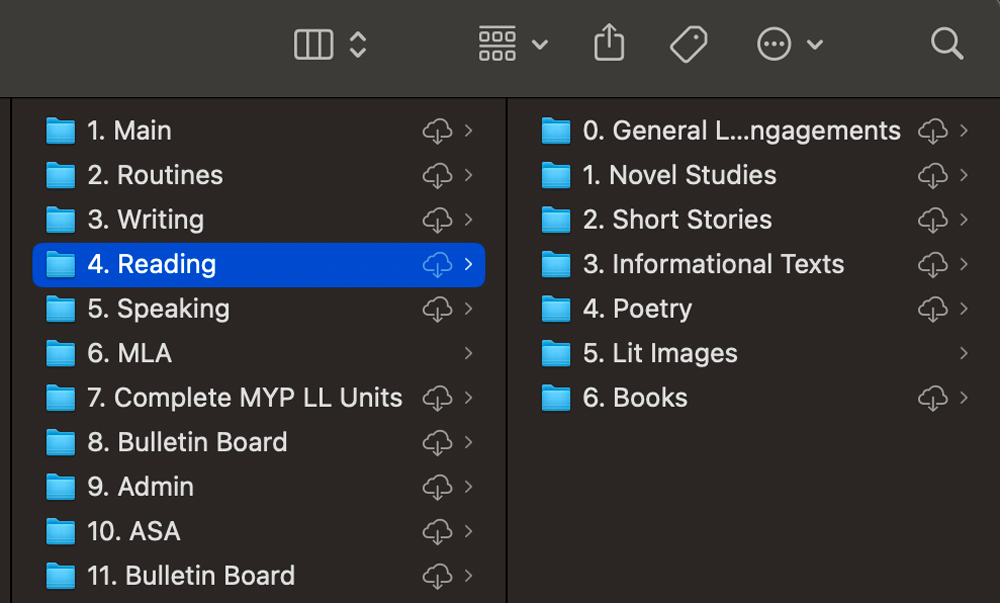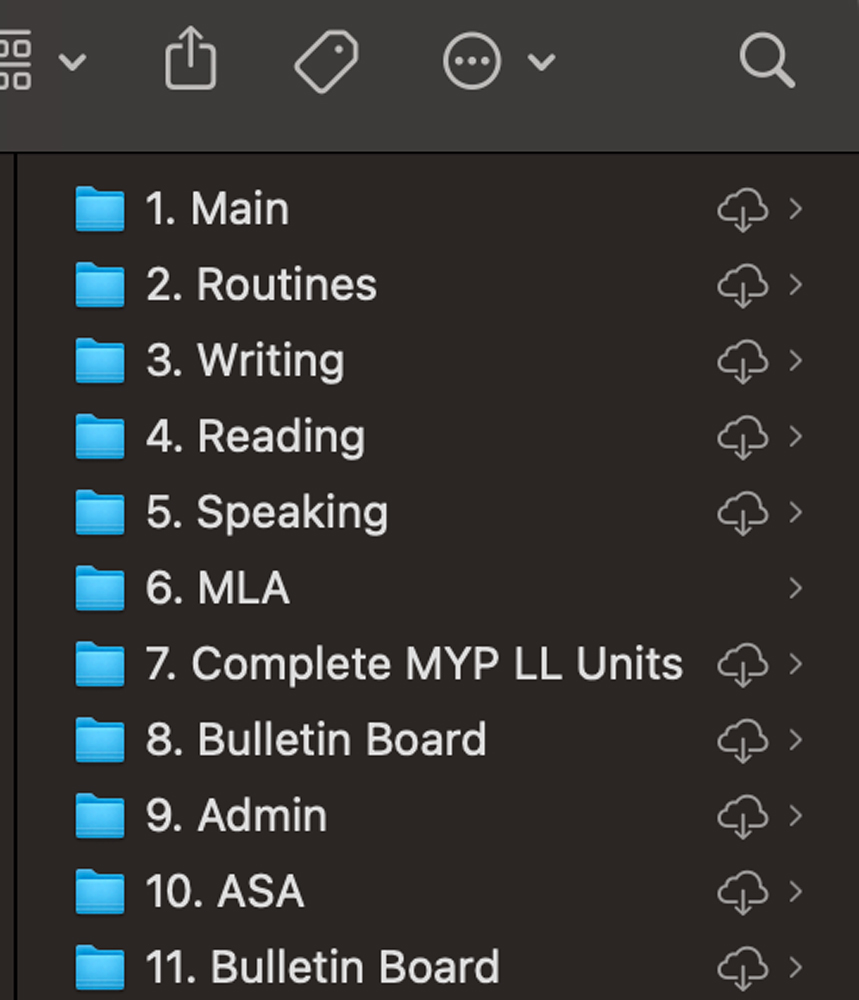
From organizing a grocery list by department to putting the pans within reach of the stove, small organizational tips can help to make our lives a little easier. Some people arrange their books by genre, some do it by author name. There is no singularly right way to organize. The goal is simply to find the book you’re looking for without searching through disorderly stacks. The same concept applies to the basics of digital organization. Educators can be more digitally efficient in various ways. Sometimes that means taking the organizational methods back to the basics and finding a system that works to reduce the demands placed on mental energy or cognitive load.
Created and researched by John Sweller, Cognitive Load Theory explains that our brains’ thinking resources are finite. Sweller explores and defines the many demands that are placed on our finite mental energy. For more information on this theory, I highly recommend Sweller’s Cognitive Load Theory in Action by Oliver Lovell.
In education, we are constantly juggling student information, pedagogy, curriculum content, meeting schedules, professional development, and so much more. Digital organization is one small way that educators and leaders can reduce cerebral demands and minimize the amount of thinking used to find files and documents, protecting finite mental resources. Starting a new school year with an uncluttered and efficient system is easier than trying to reorganize in the middle of the year.
Computer Desktops
Digital desktops with lots of documents and files impact users’ cognitive load. Opening your computer to a wall of documents, folders, images, and more can start your day with an unnecessary mental tax. Filing documents into a predictable system lessens that load. If you don’t currently have a digital organization system, here are some simple options for lightening that mental load by making your digital space a little less cluttered.
If you already have some of your own systems in place, a little brush up and clean out never hurts. You can use these ideas to augment your current system.
Keep items minimal on your desktop with minimum folders. I use just two, a personal and a professional. If you have personal files on your work laptop, or, if you are like me and using iCloud+ on your Apple devices this helps to keep the two worlds organized. If you are working from a device that is used only for schoolwork, then my suggestion is to consider making only one folder on your desktop titled Professional.
All computer files that are personal are stored in your personal file on your desktop. Professional items are stored in the professional folder. Maintaining a filing system with the personal and professional folders is the next step. The final arrangement would look like the image below:

There are many ways to organize folders. This part of the organization system can be tailored to your personal tastes and needs. I organize my professional folders by the curriculum that I teach and how content is delivered in our classroom.

Since I teach the middle year’s program (MYP) English language and literature, I have chosen to organize reading material by broad genres so that it is easier for me to ensure that students are getting a vicarious reading experience in a unit. This organizational system will look different for every educator since we work in a myriad of different curriculum frameworks. The important thing to note is that you create a system that keeps your material condensed and collected.
Creating a folder to house documents that are referenced almost daily is beneficial because it would only take one click to access. Make this file easy to find (more on that below). The impact on your cognitive load is greatly decreased when your organization is uncomplicated and simple to use.
Below is a list of documents that I maintain in my daily reference file for teaching:
For me, I call this folder that houses daily reference documents “Main.” Give it a name that resonates best with you. Once I am done teaching a unit, I move the unit plan and lesson plan compendium to another location in my professional file. I then move the next unit and lesson plans to “Main” to keep my daily reference file updated.
There are folders that I do not access daily, but often. There is a method that I have found very useful to make it easier to access more common files. I use a number system that I find useful. Folders are numbered with the following labeling structure: "1. [Name].” A folder with the number one in front of it should be one that you access most often. In the image below, notice how folders that begin with the number one in front are automatically moved to the top of the list. This is helpful for me because it puts access priority on the files that I need to use. “Main” is at the top because I use that folder daily.

This same tip is applied to documents within a specific folder for teaching; documents within a folder can be numbered based on chronological teaching order.
Managing Browser Tabs
In a Carnegie Mellon University article, Overcoming Tab Overload,the author states that researchers “found that many people struggle with tab overload, an underlying reason being that while tabs serve a variety of functions, they often do so poorly.” So, it seems intuitive to say that having a system to organize your browser tabs would lessen the cognitive load and help ease some of that mental fatigue.
There are several ways in which you can organize your browser tabs while keeping them open and accessible. My wife, who is also an educator, works efficiently with multiple browser tabs operating at a time. I can’t work with that many tabs open. More than six and my cognitive load is overrun.
My wife uses a two-window system, one for herself and one for students, with multiple tabs open related to each viewer. The first 10 tabs are essentials. The first five are email accounts, OneDrive access, PDFs that she needs to refer back to, and the school’s weekly notice from leadership. The next five tabs contain pedagogical research for her professional development.
Then, a separate window in the same browser can be used to display information to students. This individual contains content that she needs to teach: PowerPoint presentations, images, and the school’s centralized software system such as ManageBack or Moodle.
My system is different. I try to have no more than six tabs open on one browser. Any more than this and I find that it overloads my organizational abilities.
Aniket "Niki" Kittur, a professor at the Human-Computer Interaction Institute at Carnegie Mellon University said, "Managing this sort of task is really one of the most important aspects of productivity in our lives. And the number one tool that everyone uses for it is tabs, even though they don’t do a good job" (Overcoming Tab Overload).
To avoid the unnecessary cognitive load of disorganized browsers, tabs, and searches, ensure you actually have a system in place. Try out different ways and see which feels the most organized or natural for your use.
Conclusion
According to the Edutopia article, Battling Decision Fatigue, educators make approximately 1,500 decisions a day. Each decision made taxes our mental processing power, but mental energy is a finite resource. Simple, back-to-the-basics organization can create a straightforward system that lends itself to predictability and patterns, ultimately reducing cognitive load and protecting mental energy for decision-making and other demands that are placed on teachers.
--------------------------------------------------------------
Matthew Kloosterman has taught internationally for his entire career. Currently, he is an MYP English language and literature teacher at an International Baccalaureate school in Shenzhen, China.